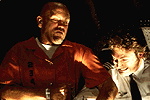[ continued from page 3 ]
The mock plane — fashioned around the chassis of a bus — was set at the top of a 15-foot ramp, from which it was propelled by the pulley system. The plane eventually reached a speed of 40mph. "We had water cannons in the pool and had the plane plow into explosives-laden limosines. The right wing, which still had an engine and a spinning propeller, crashes into a pillar holding up the Sands' parking-area awning, and the propeller bounces through the carport," Tattersall relates. (This occurs after that same propeller slices straight through the plane's cabin, interrupting a fracas between Poe and Grissom.)
Tattersall used a Night Sun, which is equipped with five 12Ks, as his key light for the sequence. "The Night Sun has its own self-contained generator, and the operator on top of the 90-foot crane arm can tweak the lights whenever needed," he notes. Fill was provided by two sets of three 10Ks aimed through 10' x 20' soft frost screens. "We hid a half-dozen 5Ks and about 40 Mole Pars in amongst the trees. The surrounding buildings were lit with 25 10Ks and four 20Ks. We were able to keep the stop at just under T4.0 using the Kodak 320 Vision stock, rated at 250 ASA."
It may be hard to believe, but the 15-camera sequence of the plane crashing into the Sands is only the picture's penultimate thrill. Following the fiery impact, a few convicts escape onto fire trucks, only to find Poe and Larkin pursuing them on police motorcycles. Says Tattersall, "This was the only scene we really weren't able to light; it just would have been too much try to light Fremont Street, which is the most brightly lit street in Vegas anyway. It was done entirely with available light [using the Vision 500 stock] except for 10-inch Kino Flo fluorescents taped to the motorcycles' speedometers, and a couple of HMI Sun Guns on the camera vehicle. This is a good example of the range of lighting styles in this picture — from 36K HMI fills, 60K Night Sun key lights and four generators to battery-operated 10-inch fluorescents and a handful of Sun Guns."
Except for these "available light" chase scenes (which were, for the most part, undercranked at a rate of 18 fps), Tattersall avoided using the 500 ASA stock on Con Air. "We felt that the 500 was too far away from the slow 5245 that we used in the Salt Flats scenes. We used the 320 stock rated at 250. 'Pulling' the exposure index lowered the contrast and allowed us to use less fill; it also improved the grain structure, giving us a much better match to the 50 ASA 5245. We used the 500 only for this chase and in the high-speed cameras."
The chase leads to a tunnel, and since none could be found in Vegas, the oft-utilized 2nd Street tunnel in downtown Los Angeles served as a substitute. "To try to make the tunnel look a little different from every other time it's been used on screen, we set it up as if it were under construction," says Tattersall. "We had towers at both ends to act as obstacles, and cables strung with 500 75-watt bulbs, placed every few feet, plus 150 randomly flashing work lights. That really made the ceramic tiles on the tunnel walls twinkle and sparkle."
Close-ups for this chase scene were captured in a parking lot with an expensive variation of a "poor man's process" — a semi-truck fitted with lights was driven by in the background to simulate the light-bedecked tunnel walls.
When the film's tense situation is eventually resolved, Poe is finally reunited with his wife and the daughter whom he's never met. To achieve an air of familial harmony, West outlined yet another dramatically different lighting scheme. Says the director, "We went ultra-simple and just had a huge wall of warm, golden flashing lights, with a wet street. And because it is the Las Vegas Strip, this type of lighting does not seem improbable. All you see are a few emergency workers and the relieved, reunited family framed against this huge wall of light. It's a sweet, poetic ending."

